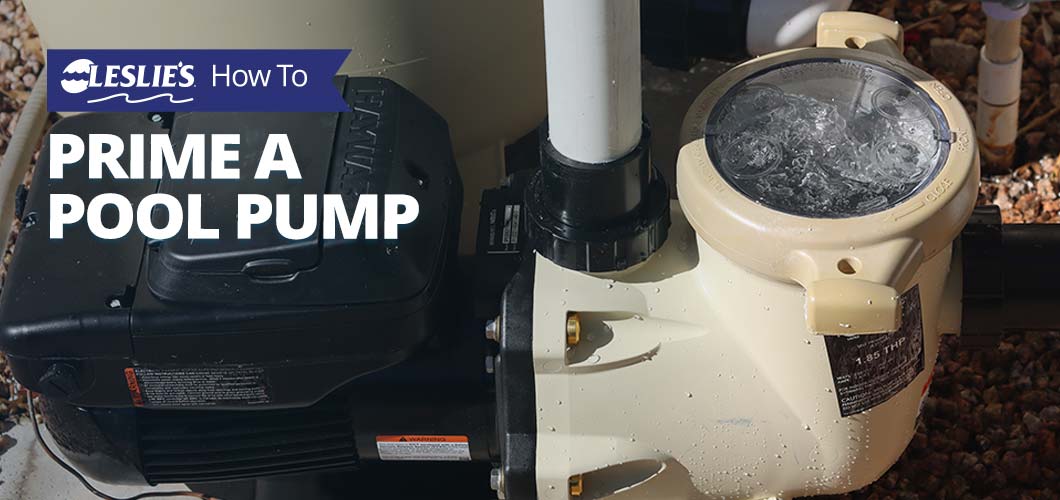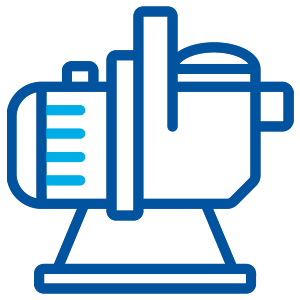
How to Prime a Pool Pump
It's a common scenario for all pool owners. At some point or another, you'll need to prime your pool pump. You may need to prime a pump while opening the pool in the spring, after changing out pool filter media or making equipment repairs, or if the pump loses prime due to a leak in the plumbing lines. There are other scenarios, as well. But these are just a few of the most common ones. Whatever the reason for priming your pool pump, this article will walk you through the steps to do it properly. Or, you can scroll down for a video that will show you the process.
Self-Priming vs. Non-Self-Priming Pool Pumps
Most residential inground pool pumps are self-priming, meaning they can re-prime or automatically generate water flow themselves using only the water in the pump strainer housing after turning on. However, these same pumps may require you to manually prime them if there are significant amounts of air in the system. This can happen after manually cleaning the filter, opening the pool in the spring, or completing pump, plumbing, or filter repairs.
If the pool equipment is above the water level of the pool or spa, a self-priming pump is required. Once primed, a self-priming pump generally won’t lose prime, even with air in the system. However, if there is a mechanical issue or leak with the filter, pump, or valves, then the pump may lose prime whenever the system shuts off.
Typically, above ground pool pumps are NOT self-priming. They technically don’t need to be, because the pump is below the water level of the pool. This type of pump is known as an end-suction or flooded suction pump. These types of pumps won’t operate properly with air in the system.
Why Prime Your Pool Pump?
It’s important to have a good prime on your pump, so it can circulate the water in your pool the way it needs to for proper sanitization and filtration. Not having a good prime on your pump could damage the pump seal, which can cause water to leak into the pump motor. If this happens, it may burn out or overheat your motor — possibly damaging pump parts and other equipment.
When to Prime a Pool Pump

There are a number of reasons your pump won't stay primed or may need to be re-primed, such as:
- Opening your pool in the spring after winterizing your pool
- A suction leak that creates air in the system
- A pressure-side leak, causing a loss of prime when the system turns off
- Low water levels, causing the pump to draw in air through the skimmer
- A skimmer weir gate stuck in the "up" position
- A clogged skimmer basket or valve
- Damaged valve O-rings or gaskets
- A loose or damaged pump lid or O-ring
- Obstructions in the pump strainer basket or impeller
- Replacing, repairing, or maintaining pool equipment
If you're having recurring issues with priming your pump, it's important to get to the root of the problem and fix the issue to avoid damaging the pump.
How to Prime a Pool Pump
Ready to prime your pool's filter pump? Follow these steps.
1. Turn Off the Pool Pump
In order to prime your pump, you’ll want to first turn off the power to the pump. If not turned off at the breaker, make sure the power cannot turn on accidently.
2. Adjust Water Flow Valves (If Applicable)
If you have a diverter valve that directs water flow from the main drain or skimmer, take note of the current position, and reposition it so water will come from the skimmer. If you have a multiport valve on your filter, set it to “Recirculate.”
3. Open the Filter's Air Relief Valve
Next, open the air relief valve on your filter, so air can be released from the system when the pump turns back on.
4. Prepare the Pump
Open the pump strainer lid and remove any debris in the basket that may impede water flow. Before placing the basket back in, check it over for cracks or damage. If damaged, you’ll want to replace it with a new strainer basket. You’ll also want to check your pump lid for any cracks, and make sure the lid O-ring is still in good condition and properly lubricated.
5. Fill the Pump with Water and Turn It On
Using a garden hose, fill the pump basket with water. You may need to run the hose for a couple minutes. Alternatively, you may be able to use a 5-gallon bucket to pour water into the pump. Once it’s full, quickly put the lid back on the housing and hand tighten it.
Now, with the air relief valve open, the diverter valve to your pool returns open, and your pump lid tightened, turn on the power to your pump.
When your pump is primed, you’ll see water flowing through the pump basket. If it’s not full and constantly flowing through the basket within 30 to 45 seconds, turn the system off and repeat all the steps. If it’s still not primed and water isn’t flowing, you likely have a suction-side or pressure-side leak in the system that needs attention. Check all lids, O-rings, valves, housings, and the filter to make sure they’re in good working condition. You can also try pushing a garden hose into the skimmer line to flush the air out before attempting to prime the pump again.
6. Close Air Relief Valve and Reposition Flow Valves
Once water begins flowing after a successful prime, you’ll begin to hear air releasing out of the relief valve on your filter. You can close the valve once the air stops and you see a steady stream of water coming out.
Let the system run for at least 30 minutes. Then you can shut off the power to the pump and return your suction-side diverter valve back to its original position (if you moved it earlier).
If you set your filter multiport valve to “Recirculate,” return it to “Filter.” Next, open up your filter’s air relief valve again and restart the pump. Once a steady stream of water spurts out, you can close the air relief valve again. Then you’re all set!
Having Trouble? Leslie's Can Help.
If your pump still won’t prime after a few attempts, and you've checked over any lids, O-rings, and the pump housing, a little more troubleshooting is probably needed. If you need assistance, the experts at Leslie’s are always here to help. Call or stop by your local Leslie's to speak with an expert, or schedule an at-home service appointment with one of our certified service technicians.